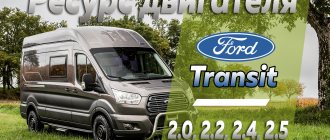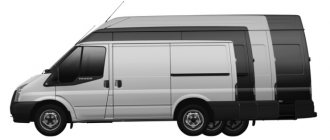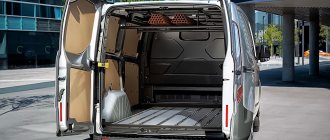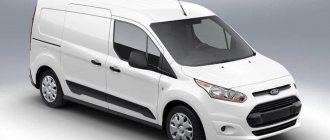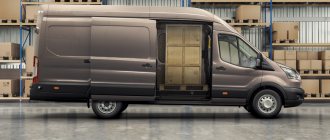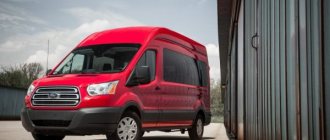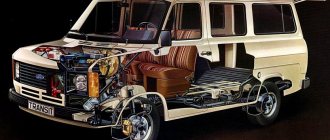The Duratorq engine line appeared in 2000. In our countries, the most common Puma engines are 2.0, 2.2 and 2.4 liter power units. These engines, designed for Ford Transit, debuted with direct injection based on Bosch VP30 and VP44 distribution fuel injection pumps, and closer to 2006 they completely switched to Common Rail injection from Delphi. These power units are still produced today. All versions of the Puma inline fours are very similar in cylinder head and cylinder block, although in 2006 and later there were some changes in their design.
On our YouTube channel you can watch a disassembly of the most popular engine for the 6th generation Ford Transit - the 2.4 DI engine (D2FA, 90 hp). This is a unit with a distribution injection pump. Engine 2.4 DI 90 hp. also installed on the LDV Convoy van and the London LTI TX-2 cab.
You can select and buy an engine for Ford Transit in our catalog of contract engines.
Gas pedal
Ford Transit may stop responding to the gas pedal. This can happen both after starting the engine and while driving. Those. the engine will run at idle speed. Also, the idle speed can be high, and the engine will not respond to gas in any way. In this case, the whole problem lies directly in the gas pedal. In case of such problems, errors are recorded indicating a malfunction of the pedal. It needs to be replaced with a new or used one. Disassembling the pedal by cleaning the contact tracks of the potentiometer and bending the contacts can also help.
Price of new and used Ford Transit
On the Russian market, Ford Transit is presented exclusively in versions with a 2.2-liter Duratorq unit with a capacity of 125 or 136 hp. At the request of the client, the car can be equipped with front-wheel drive, rear-wheel drive or all-wheel drive.
In the “minimum” version, the car has an average wheelbase and a relatively small set of equipment. The price tag for this version starts from 1.906 million rubles. Additional discounts are available through the recycling program. Versions with a long wheelbase will cost more - from 1.906 to 2.336 million rubles. Modifications with an extended wheelbase (Jumbo) are considered the most top-end. Here price tags start at 2.151 million rubles.
The market for used Ford Transit models in Russia is one of the largest. The cost of a used car varies widely and depends on the condition, year of manufacture, configuration and equipment. Thus, models from 2004-2005 on the go can be purchased for 230,000-340,000 rubles. Newer cars (2007-2009) will cost 400,000-650,000 rubles. Cars from 2011-2013 will cost from 500,000 to 900,000 rubles.
Pump and vacuum pump
The cooling system pump and vacuum pump on the 2.4 DI engine (as well as on the 2.4 TDCI engine, from 2000 to 2014) are connected together, but rotate on separate pulleys. Those. They are a two-story structure. The vacuum pump requires lubrication with oil, which is supplied to it through the pump housing. At high mileage, oil may leak through the gasket between the pump and the vacuum pump. To eliminate the leak, you need to change the gasket, which is a steel plate with two sealing rings and a sealing ring located under it on the pump.
Also, an oil leak (yes, exactly oil) can occur between the pump and the engine block. In this case, you also need to change the corresponding gasket.
You can select and buy a vacuum pump or cooling system pump for a Ford Transit engine in our catalog of contract engines.
Power plants
Throughout its production period, the Ford Transit was equipped with power units designed by the company's English division. The family of diesel truck engines was called Duratorq, however, some other models of light-duty commercial vehicles were also equipped with similar installations. Initially, the first generations of the van were equipped exclusively with gasoline engines, but soon the manufacturer added diesel analogues.
Most often, Ford Transit in Russia can be found with the following engines:
- 2.0L Duratorq TDCi;
- 2.0L EcoBoost;
- 2.2L Duratorq TDCi;
- 2.4L Duratorq TDCi;
- 2.5L Duratorq TDCi.
For a long time, the 2.0-liter gasoline engine was considered basic. In the first generations it was a small V4 engine with a displacement of two liters of the Essex family. Due to the small dimensions of the unit, Ford was able to reduce the additional length of the vehicle required to install the engine in front of the driver. Already with the release of the third generation, a 2.5-liter diesel engine with a direct fuel injection system becomes available in the engine line. The Ford Transit underwent the most extensive restyling in its fifth generation.
The model received an updated dashboard and a modified front end. At the same time, an improved power unit appears: a 2.2-liter diesel engine with a TDCi high-pressure fuel injection system. In 2002, Ford first introduced an engine with innovative HPCR technology. The sixth generation is completely equipped with Puma-type power plants. The boost level of the 2.2-liter engine reaches 135 horsepower. The same engine was installed on the Mazda BT-50, known to car enthusiasts as the Ford Ranger.
Heat exchanger thermostat
Like passenger diesel engines for the Ford Mondeo, engines for the Transit have a second thermostat to regulate the temperature in the heat exchanger. This thermostat comes with a plastic housing and an O-ring on it. It is often necessary to change this thermostat due to antifreeze leaking through its body.
Also, the heat exchanger and oil filter housing often leak oil. To eliminate the leak, you need to change the gasket between the heat exchanger and the housing, as well as the plastic oil filter cover. It is not eternal and does not hold a “twist” over time. The sealing ring of the cover comes complete with a filter insert and is replaced with every oil change.
Oil getting into antifreeze
A fairly common problem with diesel engines for Ford Transit is oil getting into the antifreeze. In many cases, the culprit is the heat exchanger above the oil filter. You will have to exchange it for a used one or buy a new one. Those. a crack appears inside its body; replacing the gasket will not help.
You can select and buy a heat exchanger for a Ford Transit engine in our catalog of contract engines.
Turbine
On diesel 2.4 with power up to 115 hp. A Mitsubishi TF035 turbine with a wastegate is installed. The turbine lasts a long time, can travel more than 500,000 km. Problems with it arise when there are problems in the engine itself. Usually due to oil quality and low oil level.
Turbines often suddenly stop working: the shaft breaks off, or the turbine begins to strongly drive oil into the intake, which at times ends in the destruction of the engine, which begins to run on this very oil, spinning up to exorbitant speeds.
You can select and buy a turbine for a Ford Transit engine in our catalog of contract engines.
Engine
Ford Transit has a wide range of power units (petrol and diesel). The key feature of the engines available for the car is their efficiency. Advanced technologies have made it possible to significantly increase the efficiency of fuel consumption and reduce emissions of harmful substances.
For the passenger version, the top-end is the modern 5-cylinder diesel 3.2-liter Duratorq TDCi unit. This is the latest engine in the line of this series. Its torque is 470 Nm, power is 200 hp. Such characteristics allow it to be one of the most powerful in its segment.
The most common in the family is considered to be the line of 2.2-liter Duratorq diesel units (this is what is offered to Russians). These motors are designed to meet the strict environmental safety requirements of Euro-4. The power of the units varies from 100 to 155 hp. They have an environmental protection and fuel saving system ECO Pack, including:
- speed limiter. Set to 100 km/h. If desired, it can be disabled so as not to degrade the technical characteristics.
- Auto-Start-Stop function (turns off the engine under certain conditions and instantly starts the engine if necessary).
Other systems found in the latest generation Ford Transit engines include an advanced battery charge management function, an energy recovery system and a gear shift indicator.
The most common problems associated with the unit:
- consumes a lot of oil;
- unstable operation (the car jerks for no reason).
Valve train chain
The double-row timing chain is the same on engines of 2.0, 2.2 and 2.4 liters, which were used on the Ford Mondeo 3 (except 2.4 liters) and on Ford Transit engines with a distribution fuel injection pump with a power of up to 95 hp. The only common rail diesel on the Transit with such a chain is the 100-horsepower 2.0 TDCi with the FIFA designation. The width of such a chain is 17 mm.
On other versions of the Duratorq diesel engine, the chain is wider - 21 mm.
And since 2007, updated diesel engines began to use a single-row chain.
The average timing chain life on Ford Transit engines is about 250,000 km. At the same time, there is a regulation from the manufacturer that the chain must be changed every 150,000 km. But at the same time, many engines have run more than 400,000 km on one chain. In any case, the chain is worth paying attention to.
It’s good if, when stretched strongly, it just starts clanging after starting the engine. But there are also sad cases when the chain broke or jumped. In this case, when pistons and valves collide, the camshaft bed breaks, and there are cases of cracking of the cylinder head.
Also, in some cases, a stretched chain is the culprit of strange engine problems. That is, if the engine starts poorly, pulls poorly, idles unstably, black smoke appears, and there are no errors, the fuel injection pump is fully operational, airing of the fuel lines is excluded, then... the timing chain needs to be inspected. Most likely, it is very stretched. Also, a stretched chain can jump 1-2 teeth; this can happen if the car is left in gear and rolls back a little.
If the chain jumps by 1-2 teeth, and it jumps only on the intake camshaft, then the intake valves will close later, therefore, the compression ratio decreases (not compression!), and the engine starts very poorly.
The timing chain drives the fuel injection pump, which is set according to marks and thus synchronizes the timing of fuel injection. That is, any deviations in the synchronization of the fuel injection pump with the camshafts are instantly reflected at the moment of injection.
In addition, if you neglect the instructions for replacing the timing chain, for example, do not fix the shafts and still rotate the crankshaft counterclockwise, then the engine with a new chain may behave like a vegetable after the first start. Those. strange problems will arise with traction, starting and all of the above. In this case, you need to check the marks everywhere in the timing belt. There will probably be a few knocked down marks.
Model history and purpose
Ford Transit is one of the oldest cars in the world. The first vehicle of this family appeared back in 1953 and was called FK 1000. In 1961, the van was renamed Ford Taunus Transit. There was no talk of export at that time. However, the production of cars gradually expanded, and the model itself experienced noticeable changes. The debut car called Ford Transit was presented in 1965. The van was produced in England, Belgium, Turkey, and then in China. The model was noticeably different from standard commercial vehicles in Europe. The wide track compared to its competitors gave many advantages, so the Ford Transit soon became very popular. In 1978, the premiere of the second generation of the model took place, which at that time was used not only in the commercial segment, but also in special services (Ambulance, Ministry of Emergency Situations, police).
4th generation
In 1986, production of the fourth generation of the model began. The car featured a “single-box” body design. The developers decided to abandon the strongly protruding hood (the windshield and hood were now located at the same angle). In 1992, the Ford Transit underwent a major restyling. The underbody has been completely redesigned and the distance between the axles has been increased. Changes also affected the design of bridges, where cylindrical bearings began to be used. The third Ford Transit was distinguished by its high maneuverability and speed, which attracted the interest of many customers. Single copies of this generation are still successfully used on the Russian market.
Read also: How many turns of thread does it work?
5th generation
In 1994, the Ford Transit underwent a restyling procedure, receiving a new dashboard and front end (the radiator grille made of horizontal bars was replaced by an oval cladding). A 2-liter engine from the Ford Scorpio has appeared in the line of power units. The third generation was sold in Europe until 2000.
6th generation
The sixth Ford Transit received a completely new appearance, borrowing features of the company's corporate identity used in the Focus model. The new modification was offered with front- and rear-wheel drive (V185 and V184). Versions with the Puma diesel engine installed in the Jaguar X-Type and Ford Mondeo were also available. An automatic transmission was offered for top-end variations. At the same time, the manufacturer took care of the driver, providing the seats and steering wheel with many adjustments, allowing you to choose the optimal position. Due to the high landing, good visibility was achieved. The interior of the Ford Transit IV became larger and was designed for 8 or 12 passengers. Based on the standard version, the automaker has also prepared a smaller version – Transit Connect. The model was made slightly smaller than the “progenitor”, adding to this a modified appearance. The maximum load capacity of the model is 900 kg.
7th generation
In 2006, the model was restyled as a new generation. The Ford Transit received new lights, interior and a redesigned front end. The gearbox has been completely changed. Diesel units received the HPCR system, and gasoline engines were borrowed from the Ford Ranger. In 2007, the Ford Transit was named Van of the Year. A little later, the line of power units was updated again. It began to include exclusively engines that comply with Euro 4. It is this variation that remains the most popular among Russians.
8th generation
In 2013, sales of the Ford Transit Custom and Ford Tourneo Custom models began in Russia. The first has become one of the best in its class due to its incredible safety and performance indicators. These versions are produced at the plant in Elabuga (Russia).
Ford Transit is used to solve a wide range of problems. The onboard modification is suitable for side and rear loading/unloading on Euro pallets. The reinforced platform allows you to transport large loads without fear for the safety of the vehicle. An easily removable awning will help protect against external factors. Ford Transit models are ideal for transport services. Passenger options are actively used in taxis on suburban and intercity routes, providing maximum comfort and safety of transportation.
Ford Transit can be called a truly iconic model, which is confirmed by the huge demand for this car.
Read also: Battery for car keys
cylinder head
On the 2.4 DI engine, in addition to the destruction of the camshaft bed, with high mileage, several rockers can break along the floors. In this case, the corresponding valves will not open.
Also, hydraulic compensators are not very durable; with a mileage of 300,000 km or more, some of them may “sag.” Those. they will become soft, causing the valves to not rise sufficiently. By the way, because of this, the engine also stops working adequately, i.e. It doesn’t pull, it doesn’t start well, and computer diagnostics won’t reveal any errors.
Assessing the condition of hydraulic compensators is very simple: you need to remove the valve cover and push through each rocker. Hydraulic compensators should not be compressed.
When the engine is running, worn hydraulic compensators knock with a frequent pulsating sound.
You can select and buy a cylinder head (cylinder head) for a Ford Transit engine in our catalog of contract engines.
injection pump
Powered by a 2.4-liter Ford Durateq DI engine producing 90 hp. Bosch VP30 distribution injection pump installed.
These distribution injection pumps have a number of unique features that make them easily adaptable to work on a wide variety of engines. First of all, this fuel injection pump is electronically controlled. This pump has its own control unit, which is located on its own body. In this case, the ECU has its own designation PSG-5. The block controls the distribution valve and pressure reducing valve. By applying voltage to the distribution valve, the block closes it, and fuel flow begins into the desired fuel line to the injector of a particular cylinder.
The immobilizer is stored in the PSG block. Those. The ignition keys are registered in the fuel pump ECU, and not in the engine control unit. Due to this, when replacing the fuel injection pump, an immobilizer must be prescribed.
What malfunctions occur with this fuel injection pump? First of all, the special transistor that controls the distribution valve burns out. If, due to poor quality fuel, the shut-off needle in the valve hangs, then the high control current will simply burn the transistor. In this case, the engine simply does not start. The manufacturer suggests replacing the ECU. But folk engineers have long since selected a suitable transistor and are offering its replacement.
The control valve may leak fuel outward. This is due to the fact that low-quality, in particular very sulfur, diesel fuel corrodes the factory sealant. Under pressure reaching 15 bar, diesel fuel leaks out through the holes for the wires. The diesel fuel flows downwards, getting onto the attachments and pipes. As you know, hot diesel fuel is worse than acid - it corrodes almost everything it comes into contact with. Combating valve leaks with traditional methods is not always successful.
When the valve needle wears out, it begins to jam and jam. This is expressed in poor engine starting, jerking and failures while driving. The valve winding may eventually burn out. By the way, the valve is screwed into the body with special force: first 80 Nm, then release 90°, then tighten it by 25 Nm and tighten it another 45°.
But if the engine starts poorly when hot, but starts confidently when cold, then the first thing you should do is check the cycle pressure. It should not be lower than 5 bar. If the pressure is lower, then you will have to change the fuel injection pump housing, because plunger is worn out.
The booster vane pump located in the housing is sensitive to the presence of water and debris in the diesel fuel, which lead to wear of its plates (vanes). Due to their wear, the fuel supply pressure drops, which leads to unstable idling, long attempts to start the engine and a decrease in power.
You can select and buy a high-pressure fuel pump (Bosch VP44 injection pump) for the Ford Transit engine in our catalog of contract engines.
FORD TRANSIT
Ford Transit 2.2 TDCi 115hp FWD MT (2009, Minibus)
Manual transmission 2200 cm³ Left New 160000 2010 - 2012 Russia St. Petersburg and Leningrad region.
Silhouette Lines 04/11/2012:
“Nice machine!
I took it for work, for my loved one. That is, so that you can comfortably move from point “A” to point “B” and have the opportunity to grab some cargo in order to save some of the costs on transport companies. My work involves frequent business trips. I travel from St. Petersburg to Moscow, to Ryazan, to Mordovia, to Penza and back to St. Petersburg. I travel 2-3 times a month. At work there is always cargo to be transported. A little in weight - from 100 to 500 kg. Small in volume - from 2-6 cubic meters. Nevertheless! Before that, I was using Padje 4. It loaded something, but you can’t put much in it, even with the rear seats folded down. And with such mileage, the operating costs turned out to be WOW! :))) I left the Padzhik for fishing trips and other outdoor activities. And for work I decided to choose a machine more suitable for solving work tasks. Where to begin? Of course, the first thing I did was read reviews online and surf the forums. “Crafter” and “Sprinter”, of course, are very fashionable, but they are large and rear-wheel drive, and of course they are expensive to maintain, especially to repair. And according to reviews from the forums, everything breaks and how! :) I read about “Boxer”. A very interesting, beautiful car, but again, according to the owners’ reviews, it is just as unreliable. Here are just some of the owners’ complaints: “The rear doors literally fall off on new cars, the body rattles, and in cold weather it drives all the oil out of the engine through the dipstick.” NO, I don’t want this “Boxer”. Although I like the Boxer and have an attractive price! In the end, I settled on the good old, time-tested Ford “Transit”. I bought a new Ford Transit 300 COMBI from the dealer, in the Trend configuration for 1,470,000 rubles. Glazed all around, with a second row of seats. Seats 2+3+further rubber floor 2m 20cm, as it turned out just right for my inflatable boat! :) Long wheelbase, medium roof, front-wheel drive, 6 gearboxes. Air conditioner. All active and passive safety systems. Power 115 hp quite enough to quickly accelerate the car to 140 km/h. Further, provided there is no headwind, the car can be accelerated to 165 km/h. The speed in the corridor is 120-140 km/h. can be considered cruising. Long wheelbase + front-wheel drive + 6 gearbox - a wonderful tandem to feel very confident on the track! On the track the car's behavior is simply fabulous! Consumption in summer with this dynamics is 11 liters. per hundred. In winter, driving speed is below 90-110 km/h. and the consumption is significantly lower - 8 liters. per hundred. By the way, consumption depends to a greater extent on the speed of movement and to a lesser extent on the weight of the cargo being transported. One refueling at a speed of up to 110 km/h is enough for 1000 km. run on the highway. The cabin is comfortable and definitely quieter than a Pajero! Which surprised and made me very happy. Driving the car is completely comparable to driving a passenger car. Acceleration in traffic, braking, maneuvering, and visibility are very comfortable. In general, I was pleased with the car! The car fully meets all my requirements for solving my transport problems, 5 points! My “Transit” is silver, all the windows in the cabin, except the cabin, were tinted “tightly”. :))) It looks, if not respectable, then at least nice! :) And also, when I bought it, the salon presented me with 16th cast wheels with tires. Beautiful wheels. THANK YOU!: That’s how I ride them. The pieces of iron with 15-gauge tires and branded hubcaps were immediately and quickly sold via the Internet. :))) To date, the mileage is 160,000 km. There were no breakdowns. Probably we can already talk about the reliability of the car as a whole, if not... In the summer I twice cooked the air conditioner tube in argon. Accordingly, I refueled it twice. They say it's caused by salt and road chemicals that corrodes aluminum. But in winter, in the coldest weather, I have already repaired the autonomous system twice. EberspeHER is standing properly, and HERE knows what else is there, but it’s acting up again. And I was asked to change it to a new one. The warranty expired at 100,000 km. And the boiler costs 39,000 + labor. Here is such a jamb with autonomy! km. The front ones take longer. The wear of the pads is not at all uniform. They simply get eaten up on the inside! For some reason there are no anthers on the inside. I only refuel on the Luka. There were no problems due to bad diesel fuel. I change the fuel filter every other time, i.e. after 40,000 km. I confirm , that the car is economical and its routine maintenance is simple and COMPLETELY inexpensive! For 2.5 years of active operation, I have not done anything to the chassis, engine or transmission. I inspect the car at the dealer. I would like to believe that specialists work there! :=) And also, in 160,000 km I have never topped up antifreeze or brake fluid. All fluids are at the level! I’m happy with the car! I would recommend it! But the conclusions and choices are up to you to make! :)" expandcollapse
Injectors
Distribution injection pump injectors are simple and reliable. They run for a long time, and if there is a malfunction, they start knocking while the engine is running. You can detect a knocking injector with the engine running by loosening the injector fittings one by one. The knocking injector will “go silent” when diesel fuel begins to seep through the fuel line nut.
By the way, these injectors perform double fuel injection. For this purpose, their design provides two springs. One allows the spray needle to open at a pressure of 225 bar, and the second at 420 bar. This is done to prevent dangerous pressure surges in the cylinders.
You can select and buy injectors for the Ford Transit engine in our catalog of contract engines.
Connecting rod bushings
Often on Puma engines the connecting rod bushing under the piston pin is destroyed. In this case, the engine operates with a characteristic knock. I have to change the connecting rod.
You can select and buy pistons and connecting rods for the Ford Transit engine in our catalog of contract engines.
You can select and buy an engine for Ford in our catalog of contract engines.
Here you can use the links to see the availability of specific Ford vehicles at the dismantling site and order auto parts from them.
